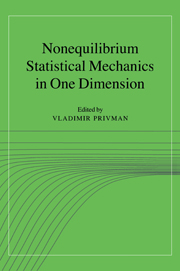Book contents
- Frontmatter
- Contents
- Contributors
- Preface
- Part I Reaction-Diffusion Systems and Models of Catalysis
- Part II Kinetic Ising Models
- 4 Kinetic Ising models with competing dynamics: mappings, correlations, steady states, and phase transitions
- 5 Glauber dynamics of the Ising model
- 6 1D kinetic Ising models at low temperatures—critical dynamics, domain growth, and freezing
- Part III Ordering, Coagulation, Phase Separation
- Part IV Random Adsorption and Relaxation Processes
- Part V Fluctuations in Particle and Surface Systems
- Part VI Diffusion and Transport in One Dimension
- Part VII Experimental Results
- Index
- Abbreviations
6 - 1D kinetic Ising models at low temperatures—critical dynamics, domain growth, and freezing
Published online by Cambridge University Press: 18 December 2009
- Frontmatter
- Contents
- Contributors
- Preface
- Part I Reaction-Diffusion Systems and Models of Catalysis
- Part II Kinetic Ising Models
- 4 Kinetic Ising models with competing dynamics: mappings, correlations, steady states, and phase transitions
- 5 Glauber dynamics of the Ising model
- 6 1D kinetic Ising models at low temperatures—critical dynamics, domain growth, and freezing
- Part III Ordering, Coagulation, Phase Separation
- Part IV Random Adsorption and Relaxation Processes
- Part V Fluctuations in Particle and Surface Systems
- Part VI Diffusion and Transport in One Dimension
- Part VII Experimental Results
- Index
- Abbreviations
Summary
Introduction
One-dimensional (1D) kinetic Ising models are arguably the simplest stochastic systems that display collective behavior. Their simplicity permits detailed calculations of dynamical behavior both at and away from equilibrium, and they are therefore ideal testbeds for theories and approximation schemes that may be applied to more complex systems. Moreover, they are useful as models of relaxation in real 1D systems, such as biopolymers.
This chapter reviews the behavior of 1D kinetic Ising models at low, but not necessarily constant, temperatures. We shall concentrate on systems whose steady states correspond to thermodynamic equilibrium, and in particular on Glauber and Kawasaki dynamics. The case of nonequilibrium competition between these two kind of dynamics is covered in Ch. 4. We have also limited the discussion to the case of nearest-neighbor interactions, and zero applied magnetic field. The unifying factor in our approach is a consideration of the effect of microscopic processes on behavior at slow time scales and long length scales. It is appropriate to consider separately the cases of constant temperature, instantaneous cooling, and slow cooling, corresponding respectively to the phenomena of critical dynamics, domain growth, and freezing.
As zero temperature is approached, the phenomenon of critical dynamics (‘critical slowing-down’) is observed in 1D Ising models. In the exactly solvable cases of uniform chains with Glauber or Kawasaki dynamics, the critical properties are simply related both to the internal microscopic processes and to the conventional Van Hove theory of critical dynamics.
- Type
- Chapter
- Information
- Nonequilibrium Statistical Mechanics in One Dimension , pp. 111 - 140Publisher: Cambridge University PressPrint publication year: 1997



